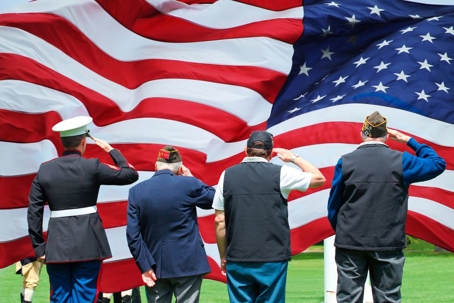“Thank you for your service,” seems like a cliché, and it certainly doesn’t seem like a strong enough statement to express gratitude to our veterans and those currently serving our country, but it’s the best way we have.
We have so many reasons to be thankful to our veterans and so many reasons to express our gratitude out loud.
Here are just 3 powerful reasons why we need to thank our veterans: service, entertainment, and innovation.
Service:
Millions of people have made the unselfish decision to serve their country in the past.
Currently, there are 19 million veterans in the United States.
Another 1.4 million people are actively serving in the military right now, using their strength, their skills, and their dedication to protect and defend our country.
Choosing to serve is a big decision.
Military people leave family behind. They endure long hours of intense physical training. (Depending on the branch of service, Boot Camp can range from a six-week stint to a thirteen-week-scenario.) They give up luxuries like long, hot showers, home-cooked meals, and the comforts of home for months. They risk life and limb. Literally. One-half of one percent of veterans are amputees because of an injury received during military service.
They are selfless and brave, believing in the “greater good.”
Thank you.
Entertainment:
Of course, we understand that military members and veterans “serve” to protect and defend us, but they are individuals with different talents and skills. Some of those people are born to entertain us.
Think about it.
Many veterans have had great careers in film, television, or music, and making us laugh, cry, or sing along.
How many veterans can you name off the top of your head who were also entertainers?
It’s a long list, but here are just a few enlistment dates of celebrity entertainers over the decades:
- 1940s: Bob Barker, Paul Newman, Johnny Carson, Bea Arthur, Tony Bennett, Hugh Hefner, Kirk Douglas, and Mel Brooks
- 1950s: Johnny Cash, Clint Eastwood, Alan Alda, Morgan Freeman, Elvis Presley, Chuck Norris
- 1960s: Jimmy Hendrix, Kris Kristofferson, Bob Ross, Tom Selleck, and Pat Sajak
- 1970s: Montel Williams, Ice-T
- 1980s: Drew Carey, M.C. Hammer
- 1990s: Sunny Anderson, Jennifer Marshall
- 2000s: Adam Driver
Several celebrities credit the military with creating a foundation for their future work in the world of entertainment. Tony Bennett played with a military band. Hugh Hefner illustrated cartoons for the Army newspaper.
Bob Ross, artist, teacher, and television personality, was working as a medical records tech stationed on Eielson Air Force Base. He was inspired to start drawing when he looked out the windows to a vast and beautiful Alaskan landscape of trees, snow, mountains, and shifting light.
Kris Kristofferson might have had an entirely different career if he had taken the teaching post he was offered at West Point. He didn’t accept it, though, because he wanted to pursue his music career instead.
Innovation:
Edwin Howard Armstrong
Not only have our military members served us and entertained us, but many smart service people have also seen problems and set out to solve them, improving our lives in the process.
Have you ever listened to the radio or watched television?
Are you connected to your cell phone?
If so, you need to thank the innovation of Edwin Howard Armstrong. As a kid, he was fascinated by the new “wireless” sets. He knew it was a problem when the Morse code signals came across and were so hard to hear, so Armstrong decided to find a way to increase the volume of signals and the distance from which they could be sent.
Armstrong entered Columbia University in the Electrical Engineering department in 1909 and created the first electronic radio receiver. During WWI, he enlisted and witnessed a bombing raid in Paris and decided to find a better way to keep track of planes.
What followed was the development of FM radio, and Armstrong’s discoveries and components are used today in every radio, television, and cell phone.
Frederick McKinley Jones
What a story!
Frederick McKinley Jones overcame a lot of adversity to become a famed inventor.
Jones was born in 1893 in Cincinnati. His mother was an African American woman who left the family when Jones was just a child. His father took Frederick to be raised by a priest when the boy was just seven. By the age of eleven, Frederick took out on his own, with minimal education.
Lack of education was not a hindrance because Frederick Jones was smart and observant. He got a job as a janitor in an automotive garage where he learned electronics and mechanics, eventually becoming the foreman of the shop. In 1912, he migrated North to Minnesota and took a job on a large farm fixing equipment and studying everything he could about wiring. By the age of twenty, he was awarded an engineering license in Minnesota.
When World War I broke out, Jones enlisted in an African American unit where he was known for his ability to fix equipment. After the war, he returned to the farm and began to branch out, building radio transmitters and a device that combined sound with moving pictures.
Frederick McKinley Jones is most known for his development of mobile refrigeration during the 1930s, a technology that a decade later would keep food, blood, and medicines safe and stable during WWII, saving thousands of lives. He founded U. S. Thermo Control Company which was worth millions of dollars by 1949.
Sixty patents later and three decades after Jones died, he was awarded the National Medal of Technology posthumously in 1991, the first black man to win it.
U.S. Army Sargeant, Gary Walters
Gary Walters joined the Louisiana Army National Guard in 1996 and served six and a half years, but when 9/11 happened, he decided to re-enlist.
His world changed when an IED hit his vehicle in 2005 and his leg was badly burned, bones in his feet were crushed, and his leg was severely broken. For almost two years, doctors tried to save the leg, but Walters decided enough was enough. His leg was amputated and he was fitted for a prosthesis.
Walters retired from the Army in 2007 and went back to school to get his engineering degree. It was there that he began working on the problem he had with his prosthesis. The connection between his limb and his prosthesis generated so much heat and sweating that wearing it for long periods of time was almost impossible. A team of four business students and four engineering students began to work on innovations that would cool the leg and promote healthy tissue growth.
They succeeded.
The team’s Aquilonix Prosthesis Cooling System won a $100,000 prize in the Student Technology Venture Competition and went to market, now helping amputees everywhere.
Thanks, Sergeant Gary Walters for your innovation and problem-solving in coming up with a solution that helps people with prostheses!
We really mean it
I learned about heating and refrigeration and air cooling in the Navy, so I understand and appreciate what it means to serve.
We really mean it when we say “Thank You” to all the veterans who’ve served in the past as well as to all the members of the military who are currently serving.


